Let’s dive in and explore stock! Plant Profiles dive deep on one plant variety. They are meant to provide you with enough information to make good growing decisions. A desire to grow gorgeous flowers is one thing. However, discerning if a particular plant is right for you and your climate is a whole other ballgame.
My intention here is to give you as much practical information to make these decisions. However, I’m going one step further and taking you completely behind the scenes to share exactly what has worked for us as well. For this reason, Plant Profiles are broken up into what I’m calling the “Nuts and Bolts (N&B)” and “Behind the Scenes (BTS).”
If you haven’t already, please be sure to read the FFY Introduction to learn more about how Plant Profiles are organized.
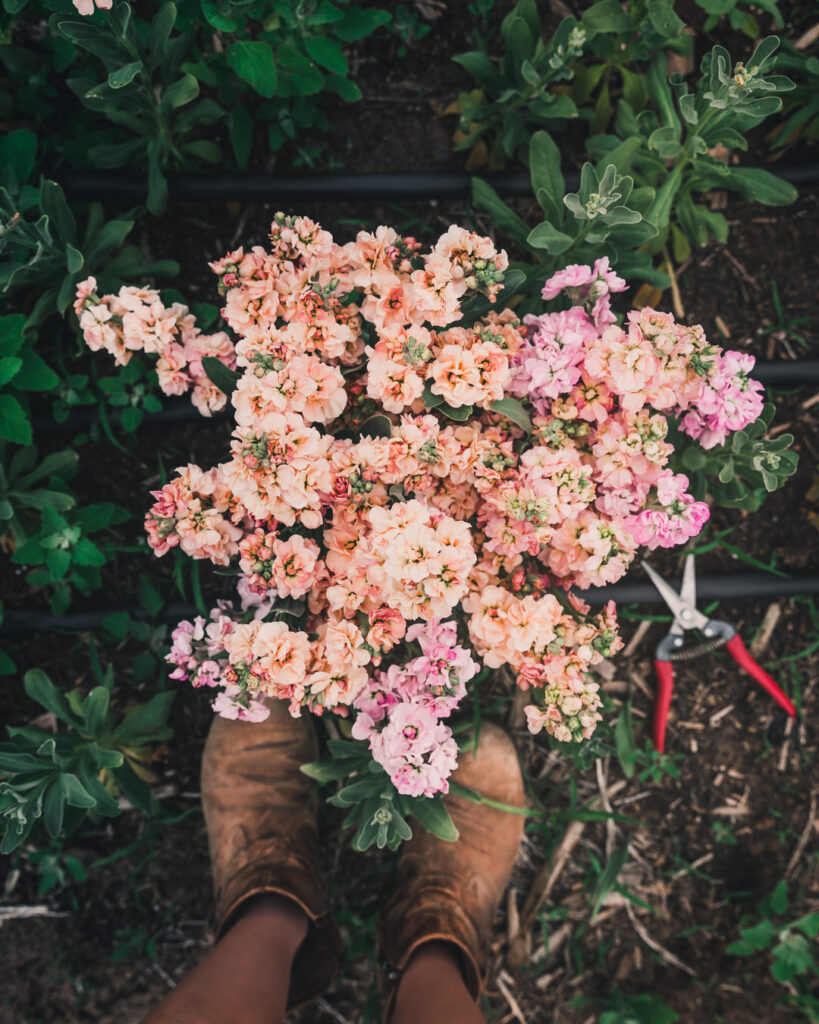
Primary Sources
The primary sources for the N&B portion come from:
- Postharvest Handling of Cut Flowers and Greens: A Practical Guide for Commercial Growers, Wholesalers & Retailers (Dole, Stamps, Carlson, et al).
- Specialty Cut Flowers, 2nd Edition, Revised & Enlarged (SCF): Industry standard for both new and experienced growers on the production of annuals, perennials, bulbs, and woody plants for fresh and dried cut flowers (Allan M. Amritage and Judy M. Laushman)
- Johnny’s Selected Seeds (Johnny’s): Johnny’s has been in the business for 50 years, with a research farm dedicated to finding the best seeds and tools for farmers and gardeners
- BOSTON Ornamental Terminal Prices. Specialty Crops Market News Federal – State Market News Service, USDA (as of 14-FEB-2023
- Stock Cut Flower Production in Utah (Maegen Lewis, Melanie Stock, Brent Black, and Dan Drost). Horticulture. Extension Utah State University
- Stock (Matthiola incana) for the Farmer Florist. Mississippi State University Extension. Publication Number: P3252
- Ball Seed
- PanAmerican Seed
- Takii Seed
Zone Considerations
Johnny’s Selected Seeds research farm is located in Zone 5a Maine
USU Trials are conducted at Greenville Farms, Zone 5 Utah and USU Botanical Center, Zone 6 Utah
My farm, Petal Back Farm, is located in Zone 4b Wisconsin
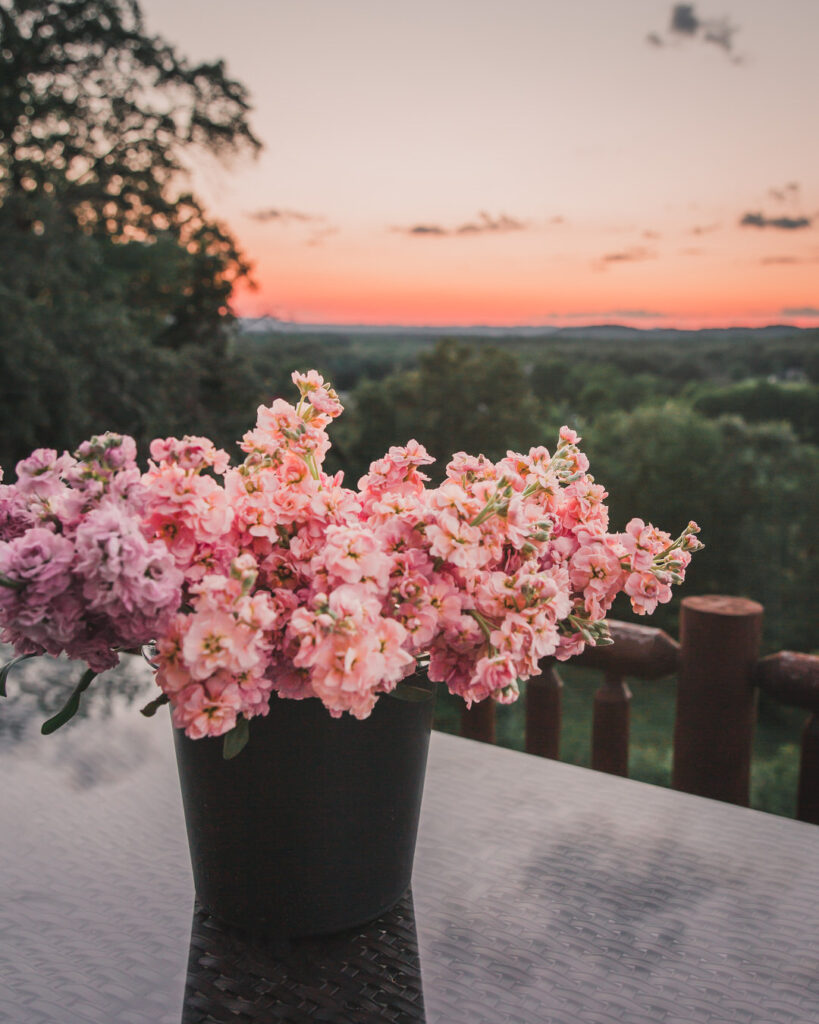
General Information: N&B
Latin Name Name: Matthiola incana
Common Name: Stock
Origin: Mediterranean
Days to Maturity: 90–105 days
Life Cycle: Annual
Spacing: 6″
Height: 24–36″
Stock is an industry standard and favorite cut flower for their form, color, and clove-like fragrance. It prefers cool temperatures for optimum flowering and quality. In fact, stock is able to withstand temperatures down to 10–20F (–12 – –7C), allowing an early crop (Johnny’s). Unless cultivars have been selected for doubleness, one can expect 50–60% doubles vs singles.
General Information: BTS
Stock is one of my all-time favorite flowers, especially for design! Those clusters of frilly flowers add such a romantic touch. They come in the best shades and I adore their clove scent. Their stems are sturdy, making them perfect for bridal bouquets (and market bouquets). They also hold up out of water and the florets work really well with floral glue for wearables. I honestly wish I could have them all season long. Even though they are a cool crop, I still can get decent stock into summer. I love it so much for wearables, I may try and extend the season even more.
If you’ve ever struggled with short or thin stems, be sure to check out the environmental factors and nutrition sections!
What I love most about stock as a cut flower:
- Romantic blooms
- Incredible colors
- Wedding design favorite
- Sturdy stems
- Popular with customers and florists
- Holds up out of water and works well with floral glue (top favorite for wearables)
- Wonderful fragrance
- Great vase life
But every rose has its thorn, right? Potential shortcomings:
- Not all are doubles (50–60% typically), though they can be selected for doubles (more below)
- Does not like warm temperatures
- Column types are single stem (one cut per plant)
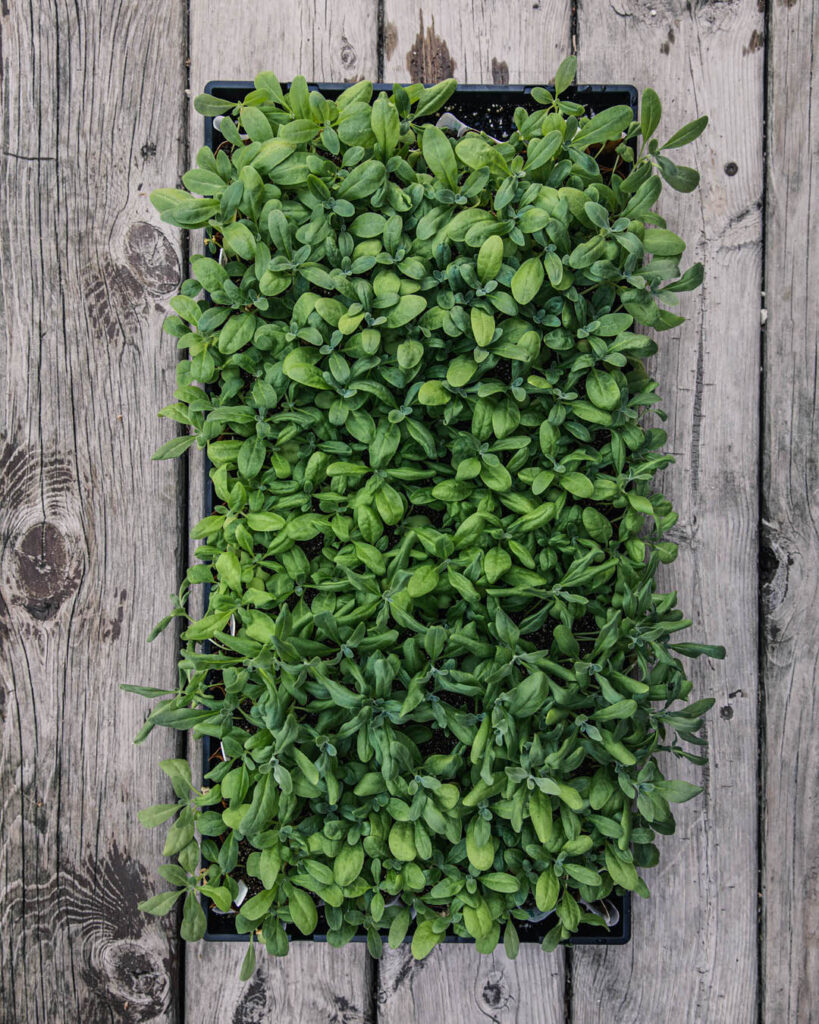
Propagation: N&B
Direct seeding is not recommended unless water levels can be perfectly maintained (SCF). Transplanting is the preferred method, particularly if you intend to select for double-flowered blooms. Sow ¼” deep into 128-cell plug flats 5-6 weeks before transplanting out into the field or protected structure. Cover lightly with fine vermiculite as light aids germination. Seeds will germinate in 7–14 days at 65–75F (18–24C).
Propagation: BTS
We grow all of our stock from seed, just as described above. I tried stock plugs last year, just to see if the quality was better, but I don’t think it’s worth the cost. Stock is really easy to start from seed.
How to Select Stock Plants for Double-Flowered Blooms
Stock can be selected for doubles based on appearance. Double florets may be selected after the cotyledons have emerged (cotyledons are the seed leaves, not true leaves). The cotyledons of single floret plants are often darker in color, fused together, and shorter, while those of doubles are lighter in color, unfused (large oval cotyledons), and are taller (USU, Johnny’s).
While assessing and selecting stock for doubles can be somewhat challenging (and depends on the cultivar), chilling the seedlings can make the differences more pronounced. To apply a cold treatment, Johnny’s recommends holding the the seedlings at about 41F (5C) for 4 to 7 days, and then following that with 1 to 2 days of temperatures at 60–65F (15–18C). This treatment should make the difference in color more apparent. Remove the darker seedlings (and don’t forget to over sow trays if you plan on doing this).


Environmental Factors: N&B
Temperature is the main environmental factor affecting flowering in stock. While there are differences between cultivars, high temperature generally delays flowering, while low temperature promotes it.
Interestingly though, SCF notes that seedlings started at too low of temperatures are dwarfed. They state that seedlings should be grown at 60–65F (15–18C) until they have approximately 8-10 leaves (10–30 days, depending on cultivar) prior to lowering temperatures for cold treatment. Note: This is NOT referring to the cold treatment for selection, but rather the cold treatment for growing on (i.e.,vernalization). It’s actually the length of this “warm” temperature that influences ultimate stem length.
After this warm period, plants should be grown on at 50–55F (10–13C). According to SCF, early-flowering types require fewer than 10 days at 50–55F (10–13C), while 3 weeks may be necessary for late-flowering cultivars. Postharvest Handling notes that there are some series that do not require cold treatments (usually those especially suited for greenhouse growing).
Stock prefers to be grown in full sun but shade cloth can be used in summer to cool the environment and promote stem length (USU).
While growing field stock is possible, it can be more challenging due to raising temperatures as the season progresses. USU recommends using low tunnels with early field transplants and shade for improved quality. In their trials of transplant timings from April through June, they found mid- to late-April (as soon as the soil could be worked) was optimal. Plants transplanted in early-May through June consistently underperformed, as air temperatures became too hot, reducing yield and marketability despite shade.
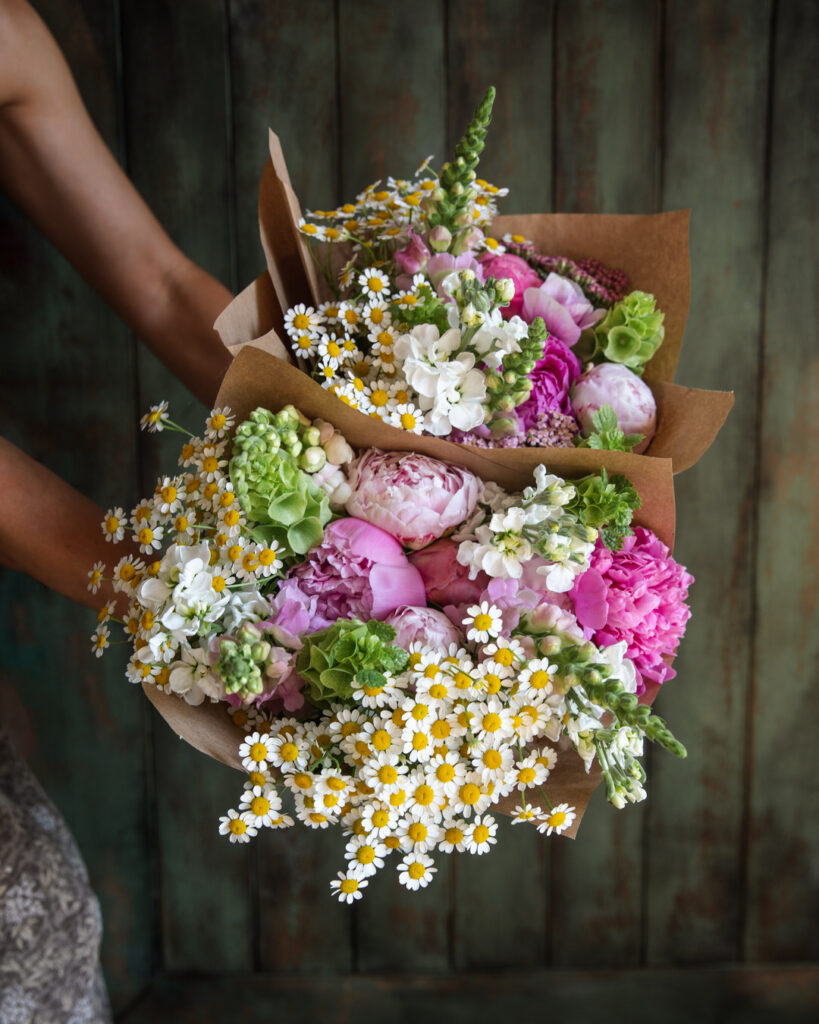
Environmental Factors: BTS
I often field questions about stem length in stock, and I always refer people to that piece of data regarding seedling temps. Since it’s widely known and reported that stock prefers cool weather, I wonder if folks that are having stem length issues are because they are introduced to cold too quickly. I don’t think the short period of cold for selection would matter, so long as they are moved back to a warmer place to grow on. We grow our seedlings on in our basement, which is about 65–68F (18–20C).
We struggle with our springs going from negative digits to extremely hot. SCF notes that some varieties will fail to initiate flowers at temperatures above 65F (18C), but we have never had an issue. This year, we had stock in the tunnel during June/July and it was much, much warmer than that. I can only assume they get enough cool weather at the beginning of our season or that the newer varieties that have come out since the publication of SCF are more tolerant. In fact, the varieties we choose to grow are the ones listed to be more heat tolerant (see Variety Selection).
While certainly our stock may not be the same quality as professional greenhouses, it’s respectable enough in my book. As someone who has ordered stock for wedding work, I actually prefer the smaller columns for design.
While I’ve grown stock in the field, I prefer to grow it in our high tunnel. Our high tunnel does also have shade cloth, which helps with temperatures and stem length.
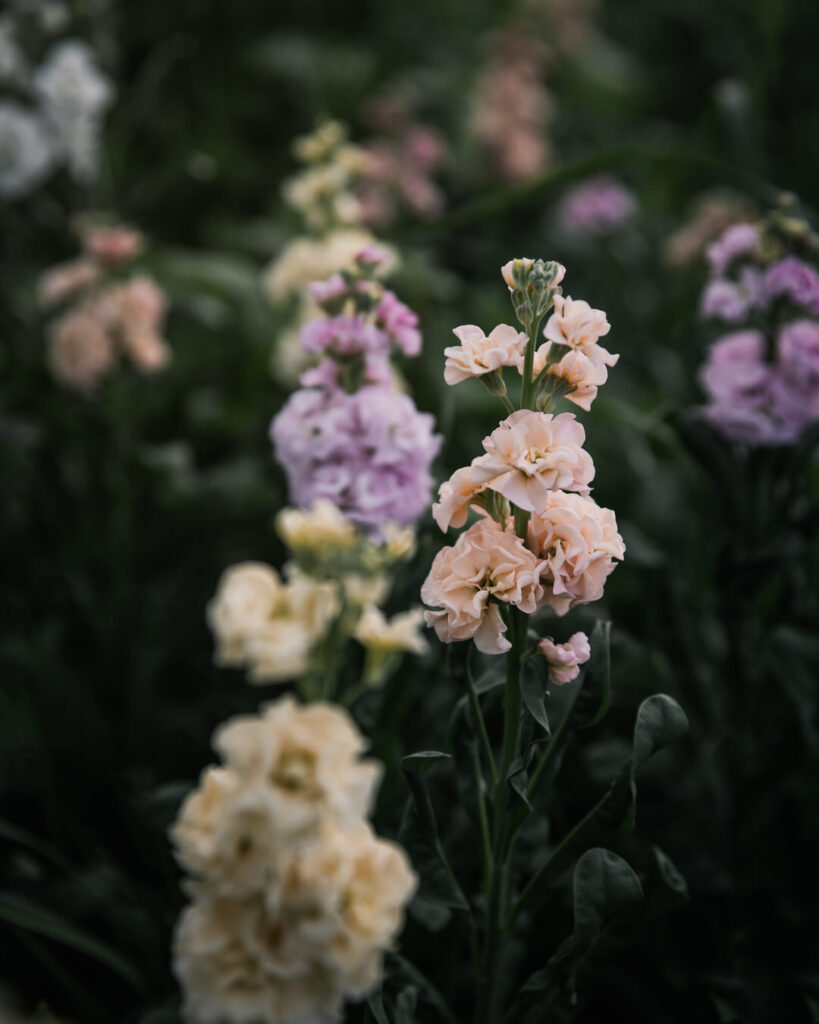
Transplanting, Spacing, Support: N&B
Based on the data about stem length, it would be ideal to transplant stock when temperatures are 50–55F (10–13C). USU recommends transplanting when plants have 8–10 leaves, while Johnny’s recommends transplanting once seedlings have 4–5 true leaves. Johnny’s notes that it’s important not to let stock become root bound and this can also stunt growth and stem length.
Space 6″ apart. USU tested 6″ and 9″ spacing and found that quality did not decline at closer spacing. All sources recommend supporting stock with netting.
Transplanting, Spacing, Support: BTS
We transplant our stock out early (March–April for the tunnel, though admittedly I’ve done it later when I fell behind). I space them at 6″. I’ve tried not using netting and it was a disaster.
Successions: N&B
In order to achieve multiple harvests, succession planting is recommended. Cool climates, start plants in winter for spring harvests or midsummer for fall harvests. Warmer climates, start in fall for winter harvests.
USU (Zone 5) found that staggered transplant dates in the high tunnel (early-March, late-March, mid-April) and field (mid-April, late-April) extend harvest up to five weeks, while still maintaining quality. They found that field plants transplanted in early-May through June consistently underperformed
Successions: BTS
We can do a couple of successions of stock in our climate. Stock does not overwinter well here. We start our stock in January and February for March through April transplants. I’d like to attempt a fall crop.
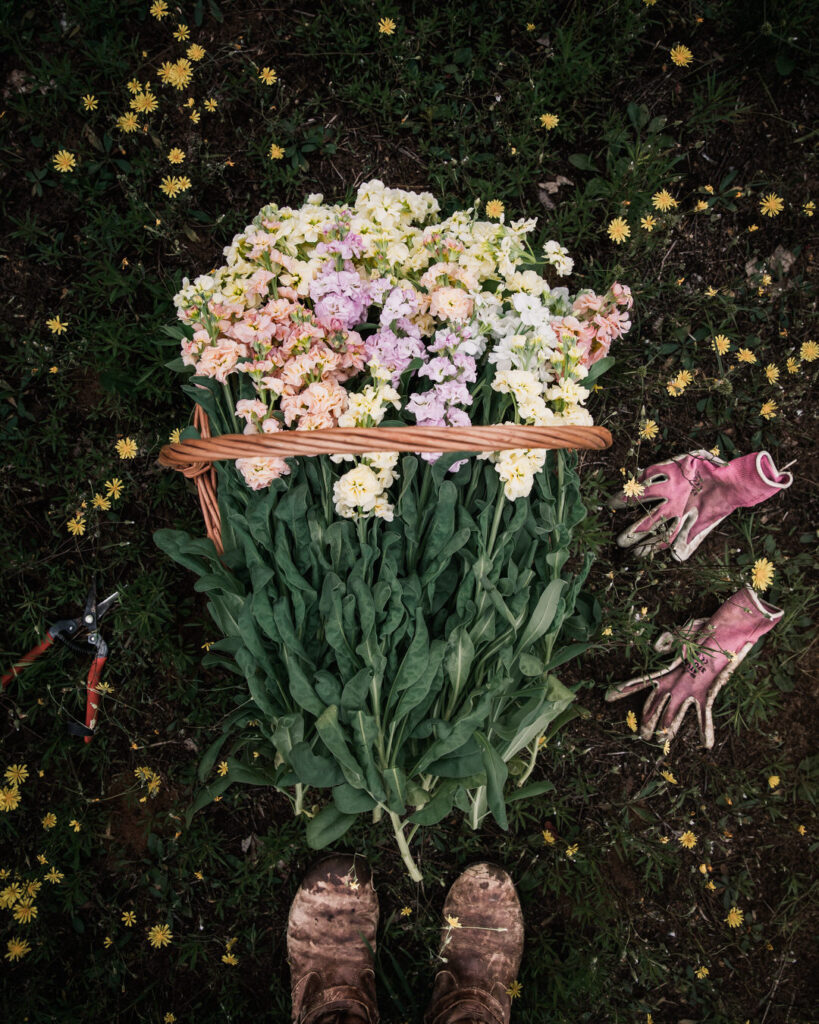
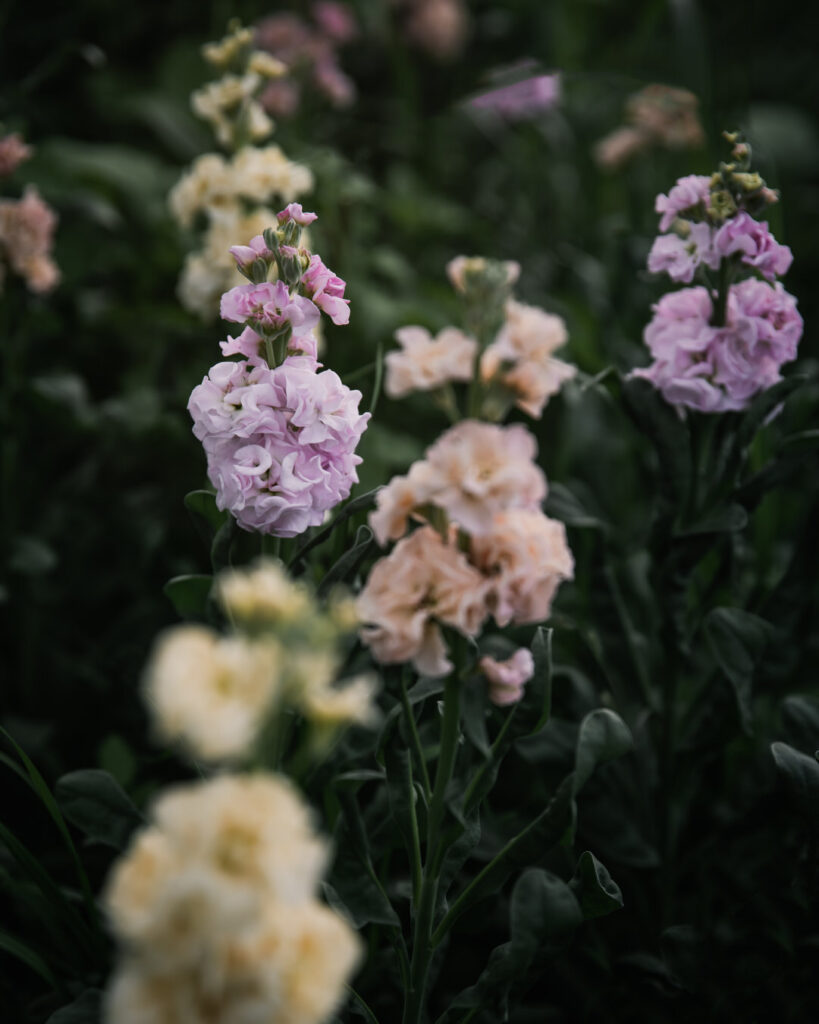
Nutrition: N&B
Stock has moderate nutrient requirements but should not be over-fertilized. High applications of nitrogen result in soft, thin stems (SCF). On the other hand, SCF and Mississippi State University both note that stock can be sensitive to potassium deficiency. Potassium deficiency causes leaves to die from the tip and margin to the base. Older leaves are the most sensitive, and the symptoms are most visible at flowering time.
Nutrition: BTS
We fertilize our fields organically based on soil tests, and we do not fertilize for each crop individually. I have an eBook that outlines exactly how we do this. I’ve made that available for you here.
Drainage, Irrigation & Mulch: N&B
According to Johnny’s, drip irrigation is recommend to avoid spotting on flower petals and reducing disease risk. For optimal growth, stock need a consistent supply of water. USU recommends applying 1 to 2 inches of water per week (½ to 1 gallon of water per square foot), depending on temperature, growth stage, and soil texture. Johnny’s and MSU recommend white plastic mulch, which reflects sunlight and keeps roots cool.
Drainage, Irrigation, & Mulch: BTS
At our farm, we have gossil-loamy sand, meaning that our soil is more sand than loam. It actually drains excessively to the point of leaching nutrients. Our biggest difficulty is keep plants irrigated, especially in dry spells. For this reason, we do have drip irrigation installed on all of our beds at the home farm. While we’ve traditionally used woven fabric mulch on our farm, I have been experimenting without using it, and the stock did just fine this year (but did get taken over by weeds eventually).
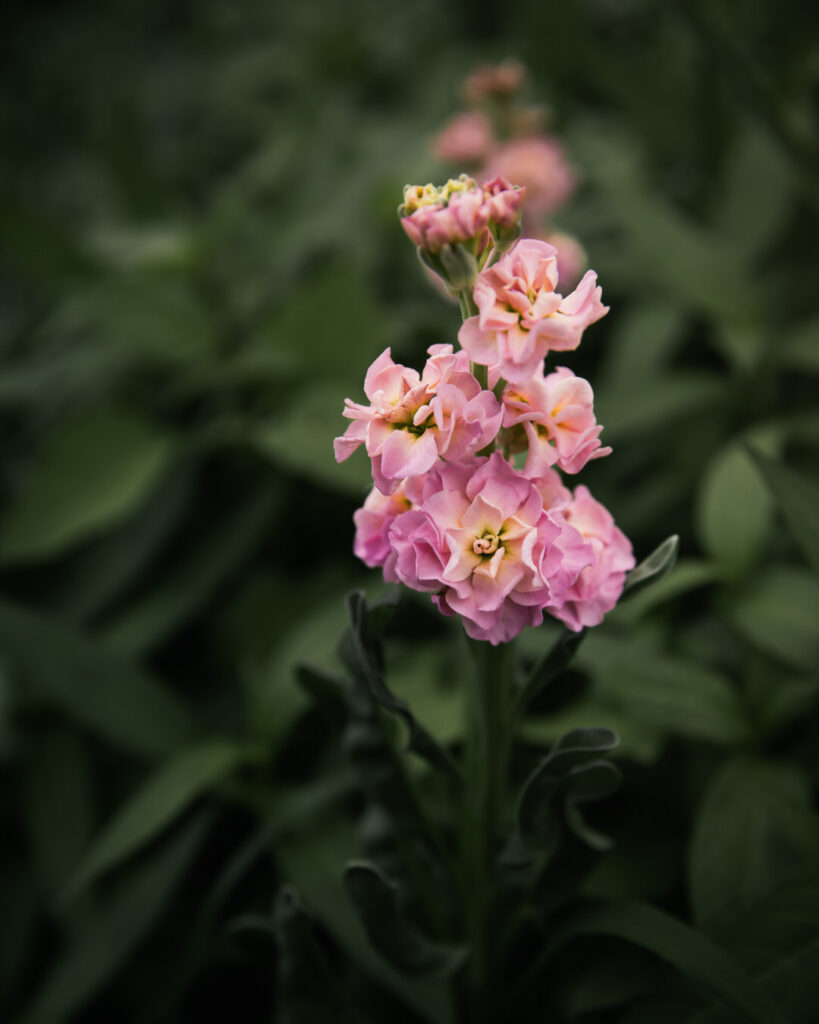
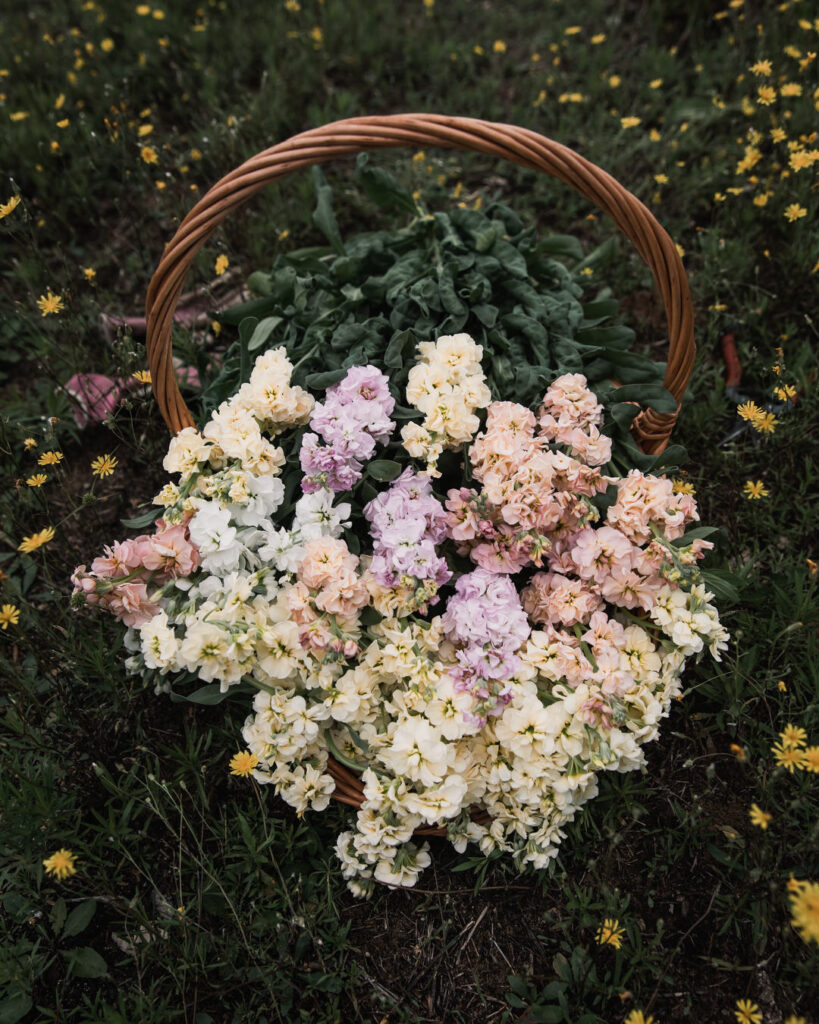
Pinching: N&B and BTS
Stock varieties are divided into two habit types, spray and column. Column varieties have only one central stem, so they should not be pinched. Spray types produce multiple stems per plant. Johnny’s explains that some spray cultivars will branch naturally without pinching but to achieve uniform height in the spray, it is necessary to pinch the pants when the first bud develops.
Bloom Period: N&B
Bloom period depends on each grower’s unique environment, and the time of year growing. When day length is at least 13 hours, a harvestable crop can be achieved within 10–12 weeks (Johnny’s). For flowering in January to March, 6–7 months is necessary unless supplemental lighting is used. Winter production (November and December planting) requires about 4 months; spring production (January–March planting, 3 months; summer production (April–July) planting, 2.5 months; fall production (August–October planting), 2–3 months (SCF).
Bloom Period: BTS
Our spring-planted stock are typically blooming in June–July.
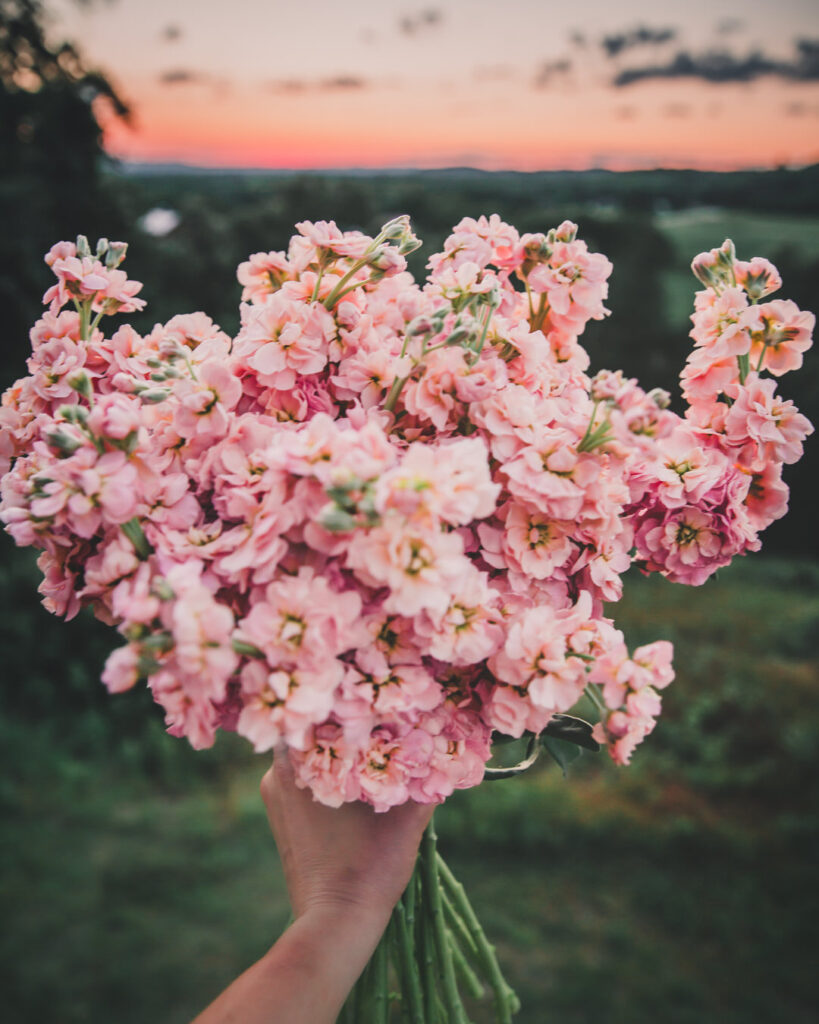
Overwintering: N&B
Stock can be overwintered in warmer zones, while spring planting is better for cooler zones (5 and colder). Stock is able to withstand temperatures down to 10–20F (–12 – –7C)
Overwintering: BTS
We do not overwinter stock.
Harvest & Post-Harvest: N&B
Harvest during the cool parts of the day when the bottom 1/3 to 1/2 of the florets are open (USU, Johnny’s). Postharvest Handling notes that those harvested with at least six florets open perform better than those harvested with fewer florets open. Of course, this will depend on the size of your stock, but one can presume a little more open is fine. Interestingly, Postharvest Handling also notes that stems may be pulled from the ground and roots removed later to increase stem length.
Postharvest Handling notes an expected vase life of 5 to 7 days in water and 7 to 10 days in preservative. Johnny’s also notes a vase life of one week. However, USU notes vase life is typically 10 days, but can be extended to two weeks with the use of floral preservatives, frequent water changes, and fresh stem cuts.
Stock should be stored at 32–35F (0–2C). Traditionally, stock is stored in buckets of water with holding solution. However, NC State trials reported that flowers of ‘Vivas Blue’ stock stored dry for up to 2 weeks had a longer vase life than wet-stored stems. Storage for longer causes loss of fragrance. Stock should be stored upright and in the dark to avoid stem elongation and curvature.
Stock can also be harvested for dry flowers. For drying, stems should be harvested when the majority of flowers are open. Dry flowers by hanging them in small bunches of 3 to 5 stems in a warm place. Fragrance may even be retrained if dried rapidly (Postharvest Handling).
Harvest & Post-Harvest: BTS
We harvest at the same stage as recommended above. Although, honestly, I don’t mind harvesting stock a little more mature. I think it’s really beautiful and it has great vase life for us, so I use it at a variety of stages. I also leave a crop forever before flipping because I love the florets for wearable work in weddings.
We use holding solution and our cooler is usually around 35F (2C) in spring and 38F (3C) in summer (if it can keep up). Typically, I’m only storing for the week for that week’s flowers, but I will store longer for weddings (even a couple of weeks). Stock is a member of the Brassicaceae and for that reason, it can get a funky vegetal smell if stored too long or the water is not changed regularly. You’ll know 🙂
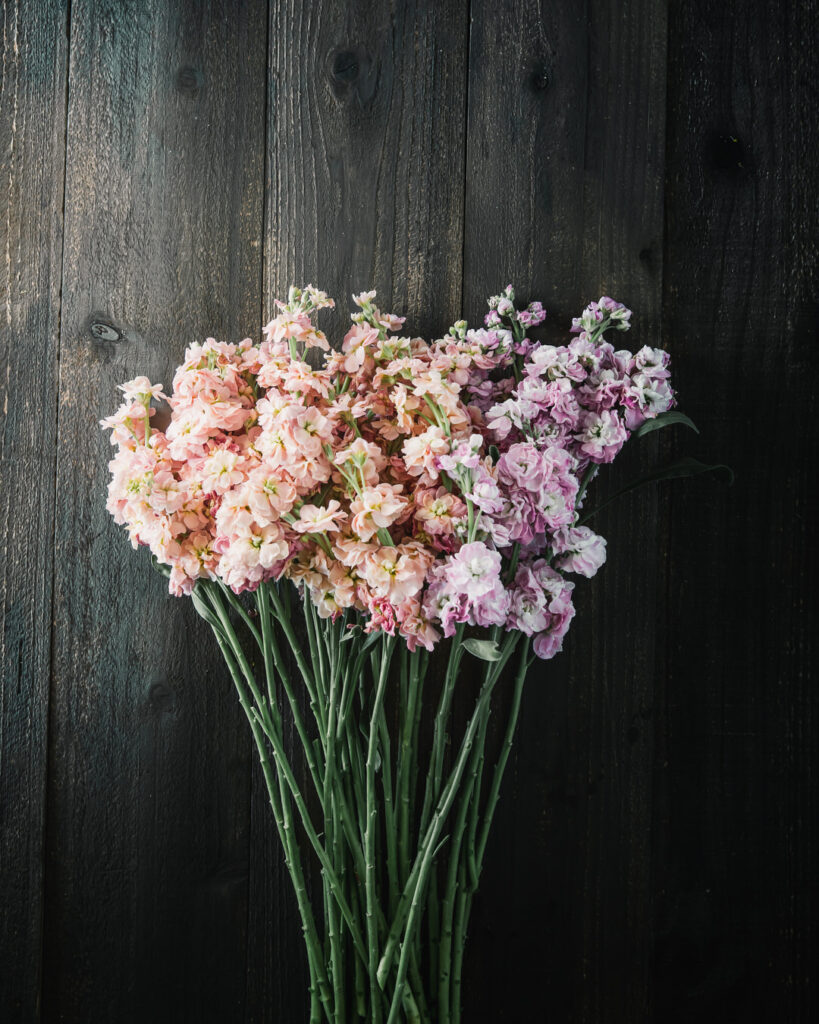
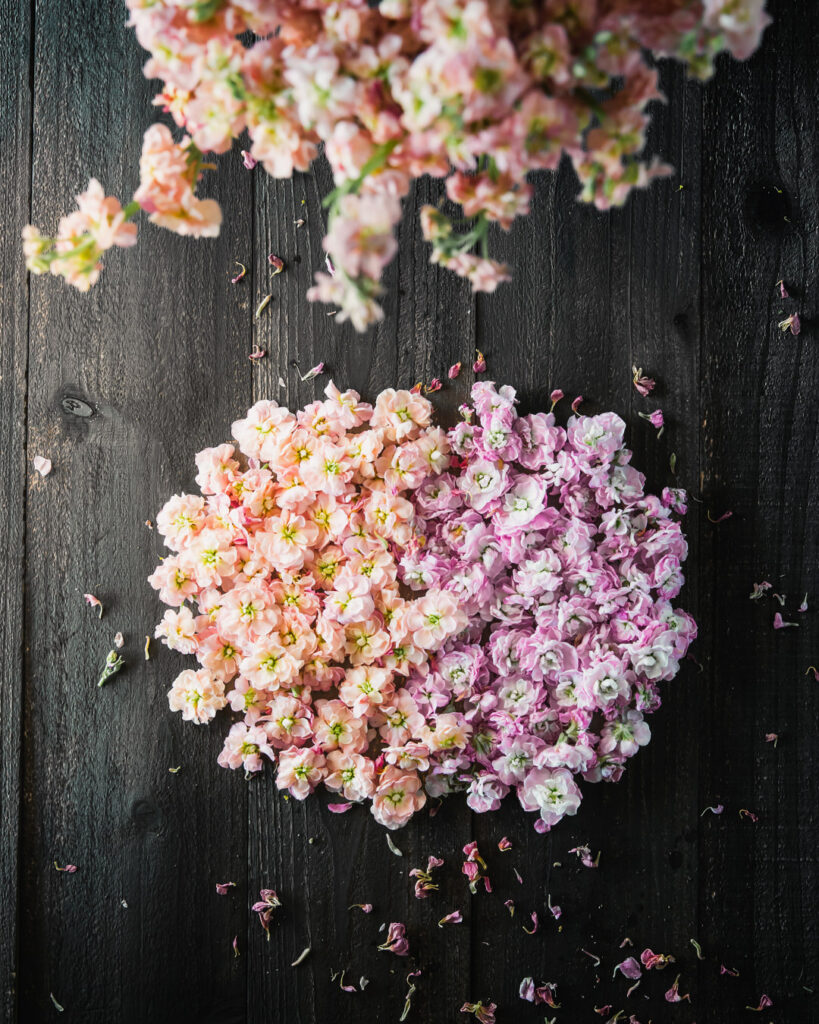
Pests & Disease: N&B
And because stock is part of the Brassicaceae family, they are affected by many of the same insect pests that affect other brassicas. As someone who started growing vegetables before flowers, this was a helpful tip for me to learn.
Aphids, whiteflies, moths, thrips, flea beetles, caterpillars, ants, and grasshoppers are some of the most common (Johnny’s, USU, SCF).
While stock are less susceptible to disease than many other garden plants, they can get downy mildew, root, stem, and crown rots, verticillium wilt, or gray mold (Johnny’s, USU, SCF).
For pest and disease control, consult Johnny’s comparison chart here.
Pests & Disease: BTS
We’ve never had any major issues with stock, except for in 2022 we had some issues with aphids. You could use a strong water stream to knock them off, but they were only on a few plants, so I simply removed the plants and discarded them.
Pests and diseases are a normal part of any farm or garden. However, I caution getting too bogged down on this piece. The reason being is that issues are so often incorrectly diagnosed and because I feel like it can become a never-ending rabbit hole for less-experienced growers worrying about an issue that may never even present itself.
On the other hand, and this is totally me the research nerd: knowledge is power! That’s why I include what’s in the current literature in the N&B section.
However, I feel like I should include some context here, so I wrote a separate article on my 3-part approach to pests and diseases after over a decade of growing. This is just my personal philosophy, so take it for what you will, but I hope it’s helpful.
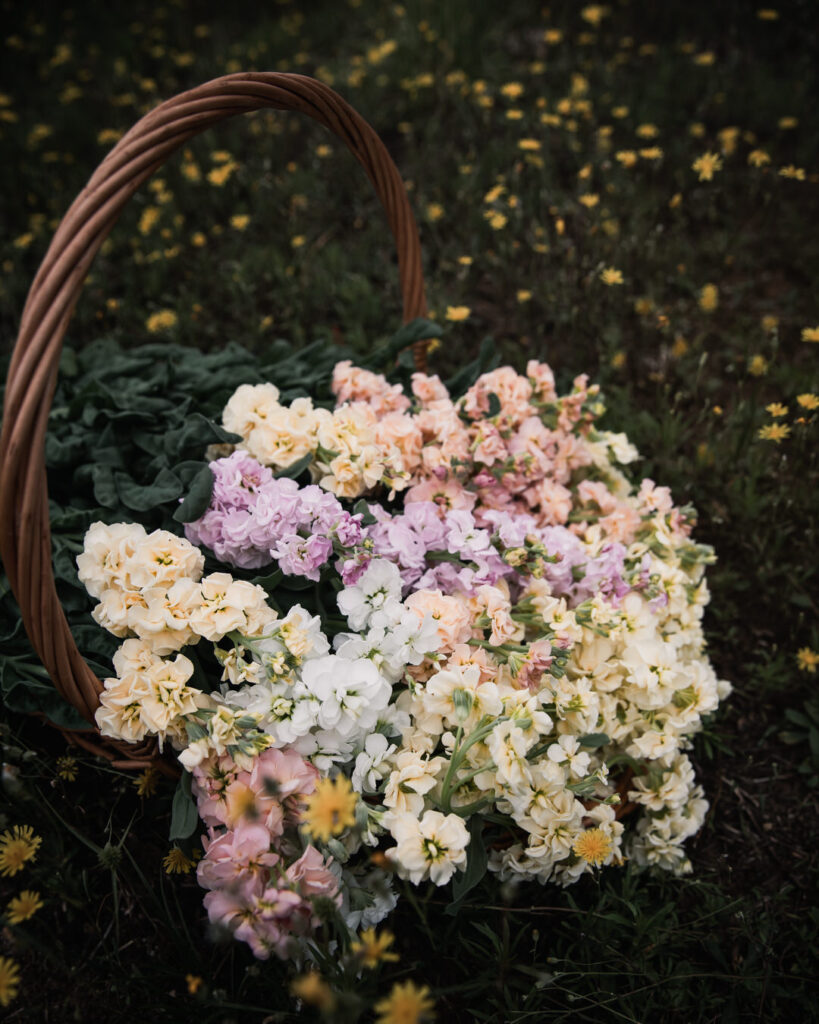

Variety Selection: N&B
There are a number of different stock series. Here are some of the most popular that are available today:
Cheerful
- Height: 36″
- 90% double-flowering plants
- Specifically bred for greenhouse production
Early Arrow
- Height: 24–30″
- “Hi-double” plants produce 90% or more double-flowering plants
- From the same breeder as the Iron Series (similar traits)
Iron
- Height: 24–28″
- Selectable four doubles
- Strong, straight, rigid stems
- Reported higher tolerance of warmer temperatures
- Compared to Katz, Iron is slightly later to flower, has somewhat shorter and thicker stems
Katz
- Height: 24–32″
- Some selection possible
- USU trials found ‘Katz’ matured two weeks earlier than ‘Iron’, but had weak stems that were more prone to curvature despite trellising
- Katz also offers high-double flowering varieties
Noble™
- Height: 30–36″
- 90% double-flowering plants
- Noble does not need as much a cold period for bud initiation as other varieties
- If it is too cold during the seedling stage the plants will be short
Opera
- Height: 32″
- Selectable for doubles
- Specifically bred for greenhouse production
Quartet
- Height: 18–24″
- Spray type
- Selectable for doubles
- Pinching is required for a well-balanced spray form
StoX®
- Height: 24–28″
- Amazing colors (just my personal opinion here)
- Selectable for doubles
Xmas
- Height: 35–39″
- Selectable for doubles
- Does well in both unheated greenhouses and outdoor field production
Below is a comparison chart from USU that you may find helpful, as it breaks down singles and doubles and marketability via high tunnel versus the field:

Variety Selection: BTS
Varieties we grow here at the farm:
Iron, StoX®, Cheerful, Katz, and Early Arrow
I’ve grown Katz Cherry Blossom and Katz Apricot for years. They are taller and more voluptuous (lol) than Iron, but I do find that their stems are a bit weaker (spindlier?) than Iron (same as reported by USU). Despite getting a really late start in spring, I completely fell in love with the Iron Pastel Mix from Johnny’s, as well as the entire line of StoX® (especially Antique Rose and Champagne). I think they’ll be even better with an earlier start.
I tried Cheerful Yellow in 2024 for the height and 90% doubles. Gol’ dang these things were tall but they were really spindly. This could have been my fault for not getting them support earlier or too much nitrogen (but I did not have this issue with Iron or Stox in same bed).
The Iron series was so uniform, I could see myself simplifying and exclusively growing Iron/Stox in the tunnel (including Early Arrow). If I was growing exclusively in the field, I would grow Katz because it is taller (though I have not tried Iron or Stox in the field).
Pricing: N&B and BTS
BOSTON Ornamental Terminal Prices as of 26-DEC-2023:
STOCK: MARKET STEADY. bunched 10s EC Double Varieties Assorted Colors exlong
14.00 long 10.00-12.00 mostly 12.00
The wholesale import price for stock ranges from $0.90-$1.35 per stem (USDA, 2021). USU-grown stock sold in bunches of 10 for $12.00 ($1.20 per stem) (USU).
I typically hoard all of my stock for weddings, events, and retail customers, but my florist price is $12.
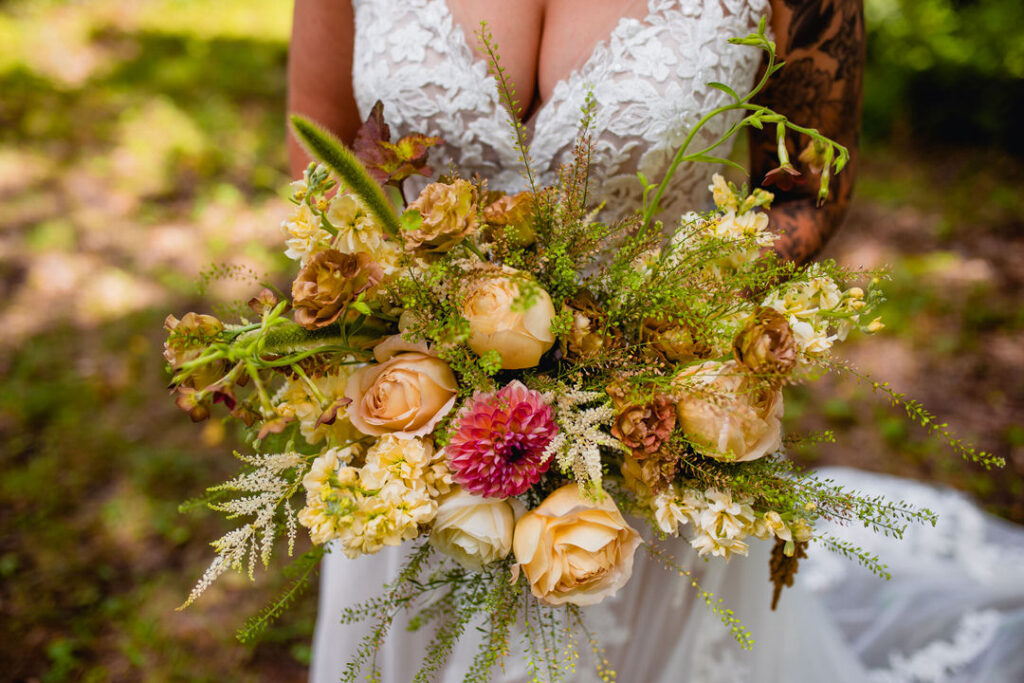
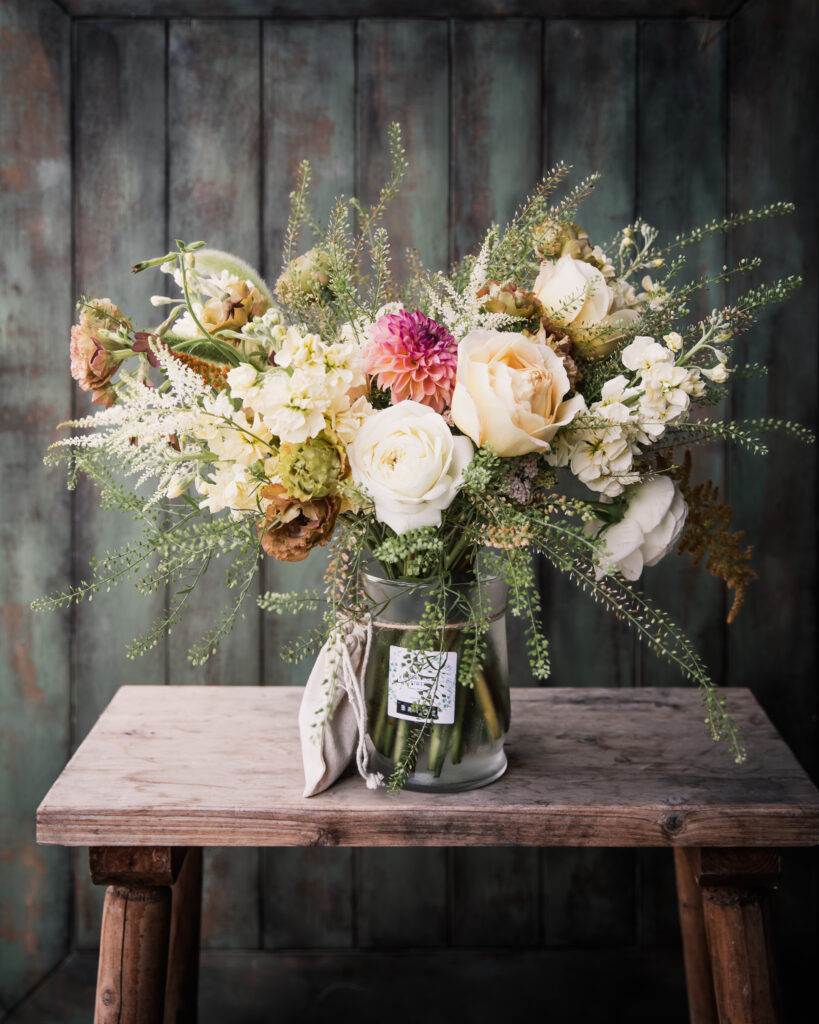
Design: BTS only
I absolutely adore stock for design. Depending on the season, we may bring in wholesale flowers if we have a really large wedding. If that’s the case, you can bet I always add stock to my order if we don’t have any available here. It’s become such a staple in my design, I’m going to attempt smaller but more successions. Even if it doesn’t do exceptionally well in the heat of summer, I adore the florets in wearables and it works really well with glue too!
Stock is one of the design flowers that wins every time for me because it has so many applications. I love creating pillows of flowers at the base of arrangements and stock is perfect for that. The multiple florets are so romantic. It’s strong stems are perfect for supporting snappier ones in bridal bouquets (and for creating more flowery pillows). They are fabulous for market bouquets too! And again: wearables! Corsages, bouts, floral crowns, I honestly use it in all of the above! And what a bang for your buck too: one stem goes a long way when you are plucking off florets. They fill in gaps in wearables beautifully.
I find stock can be used as more of a line flower (like snaps) or more of a round/disk if the growing tip is removed. Again, it’s just so dang versatile!
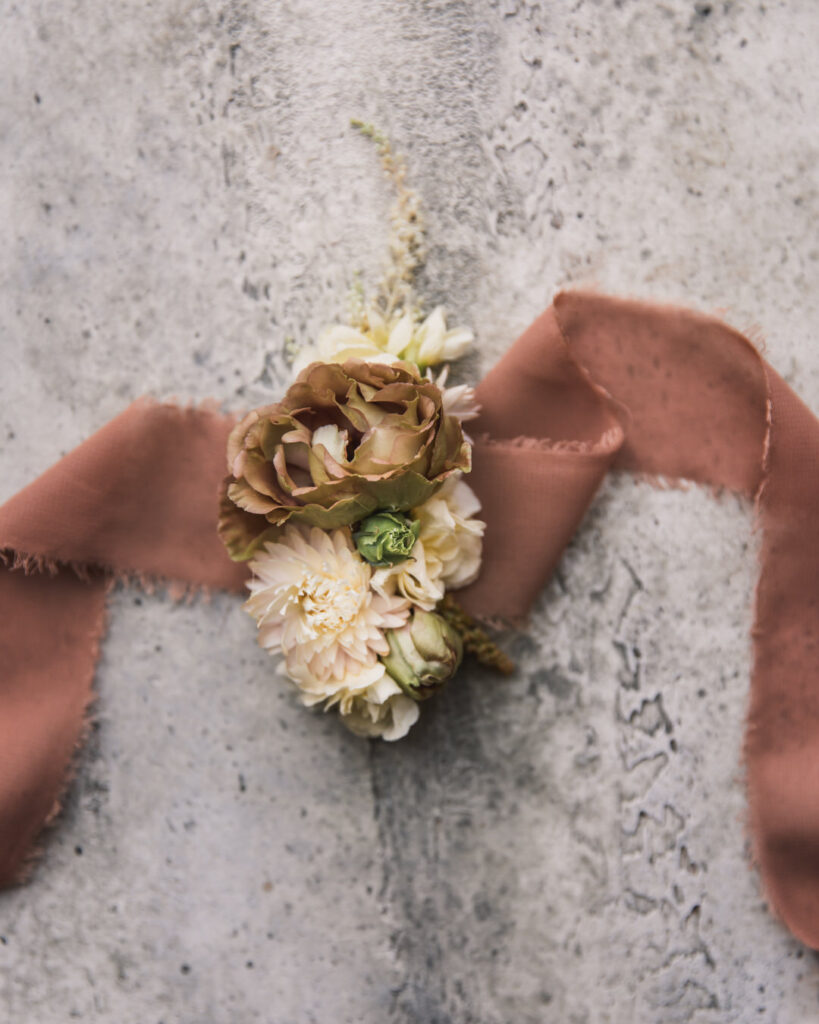
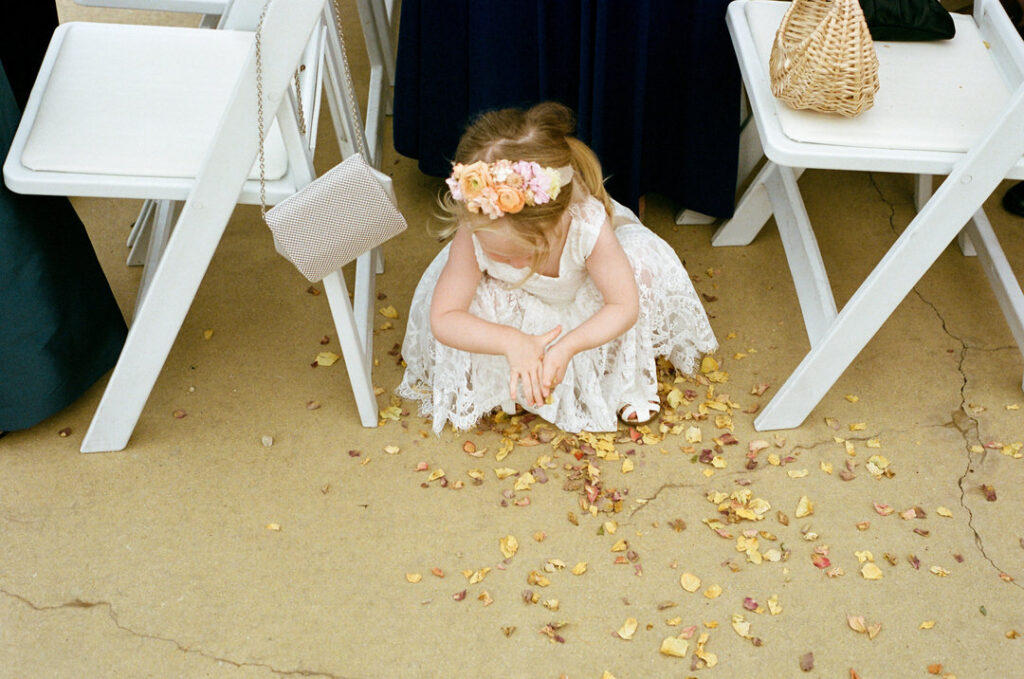
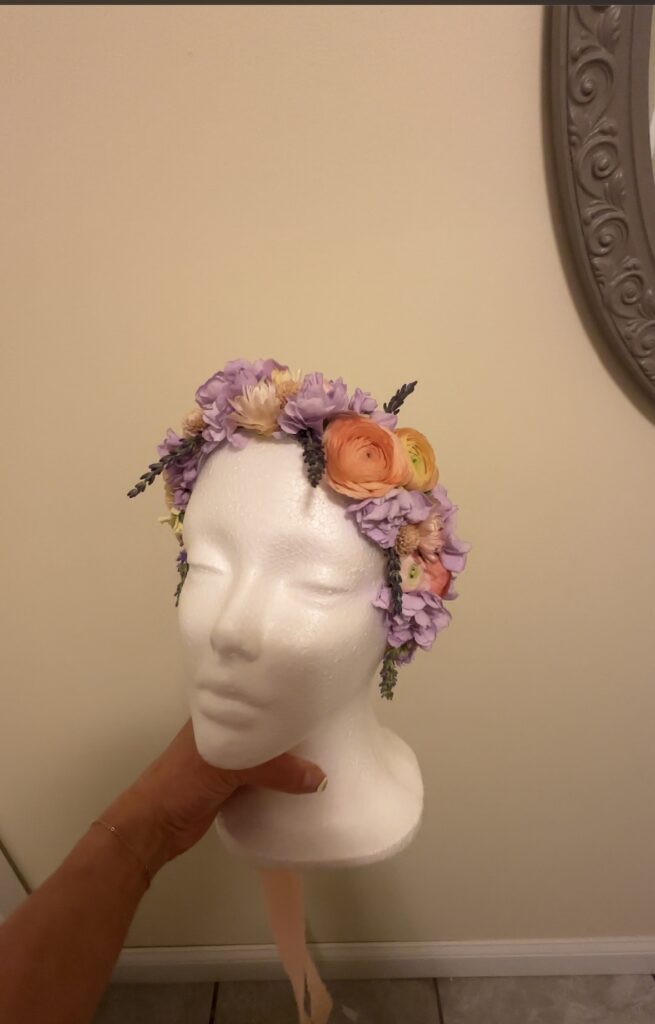
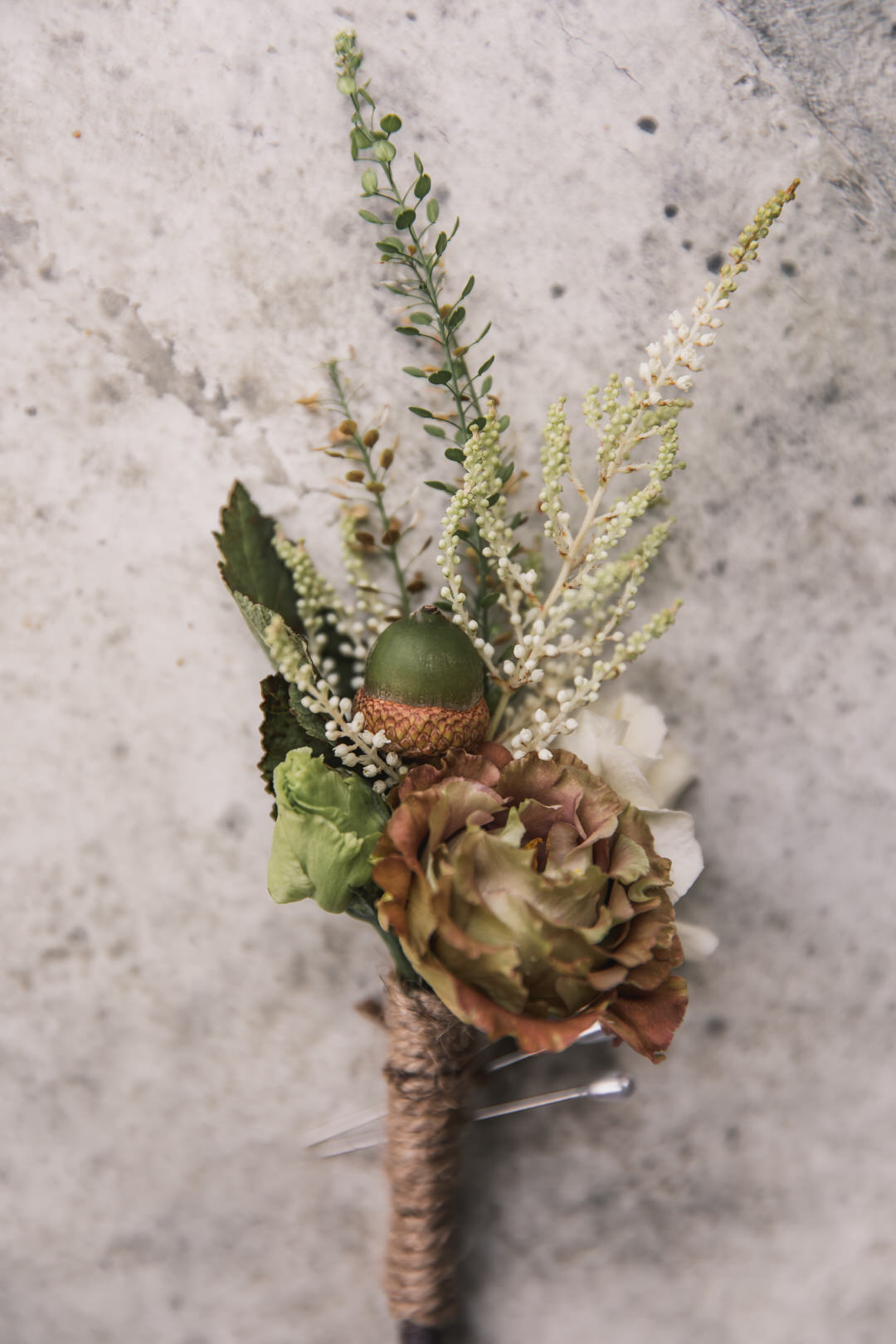
Wrap Up
OK, my friend, that is IT for this Plant Profile. What do you think? Did you find some useful nuggets? Be sure to save a PDF copy using the buttons below, so you can always refer back to it.
Have any questions or something you want to share with me or others? I know I say this ad nauseam, but I truly believe in the power of the collective and that we all have something unique and powerful to share, so please leave a question or share a comment below. We’re all better for it, and I thank you in advance!
Cheers pal!
cLICK FOR Comments +